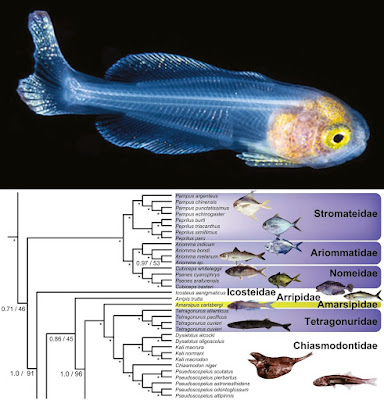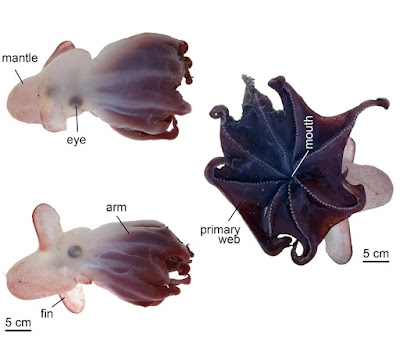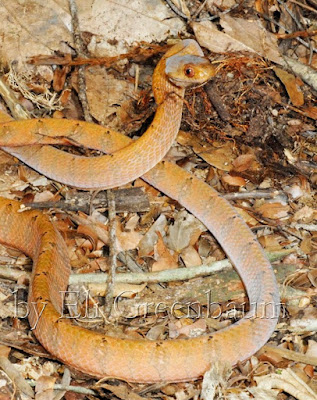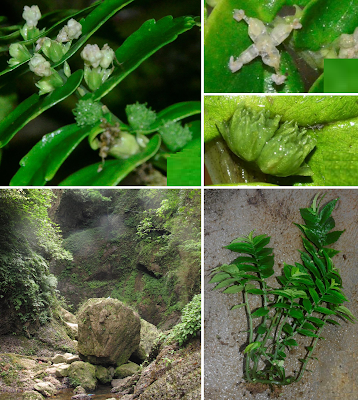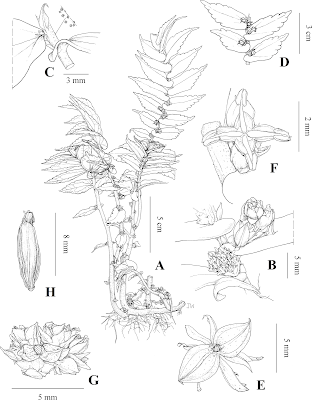[Most Recent Entries] [Calendar View]
Tuesday, April 27th, 2021
| Time | Event | ||||
| 6:03a | [Ichthyology • 2021] Phylogenomic Resolution of the Monotypic and Enigmatic Amarsipus carlsbergi, the Bagless Glassfish (Teleostei, Amarsipidae)
Abstract Amarsipus carlsbergi is a rare mesopelagic fish distributed in the Indian and Pacific Oceans and is the only species classified in the family Amarsipidae. Since its description in 1969, phylogenetic hypotheses have varied regarding its relationship with other percomorph lineages, but most have indicated a close relationship with the traditional suborder Stromateoidei. Molecular phylogenies place families previously classified in Stromateoidei within a diverse clade—Pelagiaria—that includes fishes such as tunas, cutlassfishes and pomfrets. A recent analysis of a small number of loci resolved a clade containing Amarsipus and the stromateoid lineage Tetragonurus. A subsequent high‐throughput sequence phylogeny based on ultraconserved elements (UCEs) of Pelagiaria lacked Amarsipus, but revealed both strong support for stromateoid paraphyly and high levels of gene tree incongruence. We gathered UCE sequence data for 610 UCE loci from Amarsipus and integrate these with samples from all remaining pelagiarian families. This provides a taxonomically comprehensive phylogenomic framework to test the evolutionary relationships of Amarsipus, and evaluate the support for stromateoid monophyly. As in previous studies, our analyses find high levels of gene tree topological discordance with regard to some deeper pelagiarian inter‐relationships. However, we resolve Amarsipus as the sister lineage of a clade containing Tetragonurus and a family not considered a stromateoid lineage, Chiasmodontidae. This relationship is supported by both high gene tree concordance and node support. Our analyses also provide strong support for the paraphyly of Stromateoidei, casting uncertainty on previous hypotheses of the evolution of morphological traits across members of Pelagiaria. Keywords: concordance factors, Pelagiaria, Stromateoidei, ultraconserved elements
Richard C. Harrington, Matt Friedman, Masaki Miya, Thomas J. Near and Matthew A. Campbell. 2021. Phylogenomic Resolution of the Monotypic and Enigmatic Amarsipus, the Bagless Glassfish (Teleostei, Amarsipidae). Zoologica Scripta. DOI: 10.1111/zsc.12477 | ||||
| 7:49a | [Botany • 2021] Saxifraga × klimesii (Saxifragaceae) • A New Natural Hybrid in Saxifraga sect. Porphyrion Tausch from Himalaya
Abstract A new natural hybrid Saxifraga ×klimesii Hajman, Horák & Hroneš from Ladakh (NW India) is described and illustrated. This hybrid resulted from cross between Saxifraga meeboldii Engler & Irmscher and Saxifraga pulvinaria Harry Smith. The morphology of the hybrid plants and its parental taxa was evaluated using morphometric analysis of both living plants and herbarium specimens. An artificial cross was also made to compare its morphology with spontaneous hybrids. Ploidy level and relative genome size was established using flow cytometry. Saxifraga ×klimesii is intermediate in morphology and relative genome size between both parents. It differs from S. meeboldii by shorter and wider rosette leaves and lighter yellow, larger and wider petals and from S. pulvinaria by larger rosettes, often more than one pore on leaves and usually yellow coloured petals. A lectotype is selected for S. pulvinaria. Keywords: Alpine flora, hybridisation, Ladakh, taxonomy, typification, Saxifraga Saxifraga ×klimesii Hajman, Horák & Hroneš David Horák, Martin Hajman, Michal Hroneš and Mojmír Pavelka. 2021. A New Natural Hybrid in Saxifraga sect. Porphyrion Tausch (Saxifragaceae). Phytotaxa. 498(1); 25–34. DOI: 10.11646/phytotaxa.498.1.3 Its parents are Saxifraga meeboldii and Saxifraga pulvinaria. It occurs in Ladakh, Himalaya and it is named in honor of czech botanist Leoš Klimeš who was probably its first observer. | ||||
| 12:40p | [Invertebrate • 2021] Grimpoteuthis imperator • Emperor Dumbo from the Emperor Seamounts, North Pacific: Holistic Description of New Deep Sea Megafauna (Cephalopoda: Cirrata) using A Minimally Invasive Approach
Abstract Background: In zoology, species descriptions conventionally rely on invasive morphological techniques, frequently leading to damage of the specimens and thus only a partial understanding of their structural complexity. More recently, non-destructive imaging techniques have successfully been used to describe smaller fauna, but this approach has so far not been applied to identify or describe larger animal species. Here, we present a combination of entirely non-invasive as well as minimally invasive methods that permit taxonomic descriptions of large zoological specimens in a more comprehensive manner. Results: Using the single available representative of an allegedly novel species of deep-sea cephalopod (Mollusca: Cephalopoda), digital photography, standardized external measurements, high-field magnetic resonance imaging, micro-computed tomography, and DNA barcoding were combined to gather all morphological and molecular characters relevant for a full species description. The results show that this specimen belongs to the cirrate octopod (Octopoda: Cirrata) genus Grimpoteuthis Robson, 1932. Based on the number of suckers, position of web nodules, cirrus length, presence of a radula, and various shell characters, the specimen is designated as the holotype of a new species of dumbo octopus, Grimpoteuthis imperator sp. nov. The digital nature of the acquired data permits a seamless online deposition of raw as well as derived morphological and molecular datasets in publicly accessible repositories. Conclusions: Using high-resolution, non-invasive imaging systems intended for the analysis of larger biological objects, all external as well as internal morphological character states relevant for the identification of a new megafaunal species were obtained. Potentially harmful effects on this unique deep-sea cephalopod specimen were avoided by scanning the fixed animal without admixture of a contrast agent. Additional support for the taxonomic placement of the new dumbo octopus species was obtained through DNA barcoding, further underlining the importance of combining morphological and molecular datasets for a holistic description of zoological specimens. Keywords: Magnetic resonance imaging, Micro-computed tomography, Three-dimensional, Modelling, Taxonomy, Cephalopod, Cirrate, Dumbo
Family Grimpoteuthidae O’Shea, 1999 Genus Grimpoteuthis Robson, 1932 Type species: Cirroteuthis umbellata Fischer, 1883: 404. By original designation, Robson 1932: 137. Grimpoteuthis imperator sp. nov. Diagnosis: Medium-sized species with moderately long, lateral fins. Cirri short and suckers moderate. Gills compact with eight broad lamellae. Radula present, teeth homodont. Paired anterior and unpaired posterior salivary glands present. Shell U-shaped, smooth with lateral wings parallel, broadly tapering towards distal ends. Distribution: So far known only from the type locality in the northern part of the Emperor Seamounts, an undersea mountain chain in the northwestern part of the North Pacific. Etymology: Latin, imperator, noun in apposition. Named after the Emperor Seamounts to which the type locality belongs. Proposed vernacular names are Emperor Dumbo (English), Dumbo impérial (French), 天皇ダンボ (Japanese), and Kaiserdumbo (German). Conclusions: By extending the morphomics concept to the description of a new species of megafauna, we here show that a minimally invasive approach based on the application of complementary non-invasive 3D imaging techniques supplemented with molecular sequence data can help to advance metazoan taxonomy, in particular, in cases where valuable, larger zoological specimens require a more detailed, holistic analysis. Alexander Ziegler and Christina Sagorny. 2021. Holistic Description of New Deep Sea Megafauna (Cephalopoda: Cirrata) using A Minimally Invasive Approach. BMC Biology. 19: 81. DOI: 10.1186/s12915-021-01000-9 Alan J. Jamieson and Michael Vecchione. 2020. First in situ observation of Cephalopoda at hadal depths (Octopoda: Opisthoteuthidae: Grimpoteuthis sp.). Marine Biology. 167, 82. DOI 10.1007/s00227-020-03701-1 Open Access Footage captured of cephalopod at deepest ocean level ever observed | ||||
| 12:41p | [Herpetology • 2021] Night Stalkers from Above: A Monograph of Toxicodryas Tree Snakes (Squamata: Colubridae) with Descriptions of Two New Cryptic Species from Central Africa
Abstract The genus Toxicodryas, historically included with the renowned Australasian cat-eyed snakes of the colubrid genus Boiga, currently includes two widespread species (T. blandingii and T. pulverulenta) in western, central, and eastern Africa. We leverage findings from a recent phylogenomic and historical demographic analysis of this genus (based on 2848–4471 Rad-seq loci from across the genome), with robust sampling from throughout the ranges of both species, to define two additional taxonomic units, with species boundaries corresponding to river barriers. Additional morphometric data from scores of examined museum specimens and literature records bolster the recognition of these two new cryptic species. We hypothesize that T. blandingii occurs west of the confluence of the Congo and Ubangi rivers, whereas a cryptic new species that is found east of this biogeographic barrier has significantly higher numbers of ventral scale counts in both sexes, additional significant differences in several scale counts, and lower venom toxicity. Toxicodryas pulverulenta occurs west of the Niger Delta in West Africa, whereas a cryptic new species that is found east of this biogeographic barrier has significantly higher numbers of subcaudal scale counts in both sexes. A review of published information regarding morphological variation, ecology, natural history, habitat, and venom is summarized for these four Toxicodryas species. Keywords: Reptilia, Congo Basin, arboreal, cryptic species, rivers, taxonomy Eli Greenbaum, Kaitlin E. Allen, Eugene R. Vaughan, Olivier S. G. Pauwels, Van Wallach, Chifundera Kusamba, Wandege M. Muninga, Mwenebatu M. Aristote, Franck M. M. Mali, Gabriel Badjedjea, Johannes Penner, Mark-Oliver Rödel, Jacqueline Rivera, Viktoria Sterkhova, Grant Johnson, Walter P. Tapondjou N. and Rafe M. Brown. 2021. Night Stalkers from Above: A Monograph of Toxicodryas Tree Snakes (Squamata: Colubridae) with Descriptions of Two New Cryptic Species from Central Africa. Zootaxa. 4965(1); 1–44. DOI: 10.11646/zootaxa.4965.1.1 | ||||
| 1:12p | [Botany • 2021] Elatostema qinzhouense (Urticaceae) • A New Species from Limestone Karst in Guangxi, China
Abstract Elatostema qinzhouense L.F. Fu, A.K. Monro & Y.G. Wei, a new species from Guangxi, China is described and illustrated. Morphologically, E. qinzhouense is most similar to E. hezhouense from which it differs by having smaller size of leaf laminae, fewer and smaller staminate peduncle bracts, longer pistillate peduncle bracts and a larger achene. This result is supported by the molecular evidence. The phylogenetic position of the new species within Elatostema is evaluated using three DNA regions, ITS, trnH-psbA and psbM-trnD, for 107 taxa of Elatostema s.l. (including E. qinzhouense). Bayesian inference (BI) and maximum likelihood (ML) analyses each recovered the same strongly supported tree topologies, indicating that E. qinzhouense is a member of the core Elatostema clade and sister to E. hezhouense. Along with the phylogenetic studies, plastid genome and ribosomal DNA (rDNA) sequences of the new species are assembled and annotated. The plastid genome is 150,398 bp in length and comprises two inverted repeats (IRs) of 24,688 bp separated by a large single-copy of 83,919 bp and a small single-copy of 17,103 bp. A total of 113 functional genes are recovered, comprising 79 protein-coding genes, 30 tRNA genes, and four rRNA genes. The rDNA is 5,804 bp in length and comprised the 18S ribosomal RNA partial sequence (1,809 bp), internal transcribed spacer 1 (213 bp), 5.8S ribosomal RNA (164 bp), internal transcribed spacer 2 (248 bp) and 26S ribosomal RNA partial sequence (3,370 bp). In addition, the chromosome number of E. qinzhouense is observed to be 2n = 26, suggesting that the species is diploid. Given a consistent relationship between ploidy level and reproductive system in Elatostema, the new species is also considered to be sexually reproducing. Our assessment of the extinction threat for E. qinzhouense is that it is Endangered (EN) according to the criteria of the International Union for Conservation of Nature. Elatostema qinzhouense L.F. Fu, A.K. Monro & Y.G. Wei, sp. nov. Diagnosis. Most similar to Elatostema hezhouense from which it differs by the smaller size of leaf laminae (10–45 × 6–15 mm vs. 55–115 × 20–25 mm), fewer and smaller staminate peduncle bracts (1, 1 mm vs. 2, 3.5 mm), longer pistillate peduncle bract (0.900 mm vs. 0.375 mm) and a larger achene (0.86–0.94 × 0.27–0.30 mm vs. 0.6 × 0.25 mm) (see Table 4). Distribution and habitat. Elatostema qinzhouense is known from a single locality in Lingshan County, Qinzhou City, Guangxi, China. E. qinzhouense is likely calcicolous and grows under evergreen broad-leaved forest on limestone hills. Flowering from December to March, fruiting from March to April. Etymology. Elatostema qinzhouense is named after the type locality, Qinzhou City, Guangxi Zhuang Autonomous Region, China. Vernacular name. 钦州楼梯草 (Chinese name). Longfei Fu, Alexandre K. Monro, Tiange Yang, Fang Wen, Bo Pan, Zibing Xin, Zhixiang Zhang and Yigang Wei. 2021. Elatostema qinzhouense (Urticaceae), A New Species from Limestone Karst in Guangxi, China. PeerJ. 9:e11148 . DOI: 10.7717/peerj.11148 |
| << Previous Day |
2021/04/27 [Calendar] |
Next Day >> |
